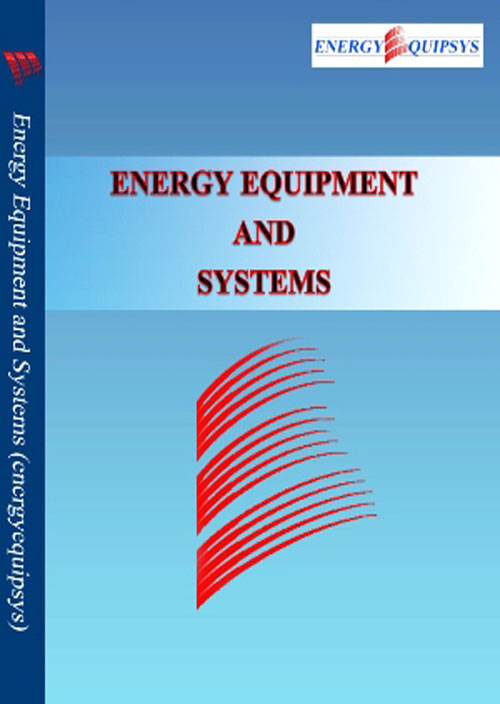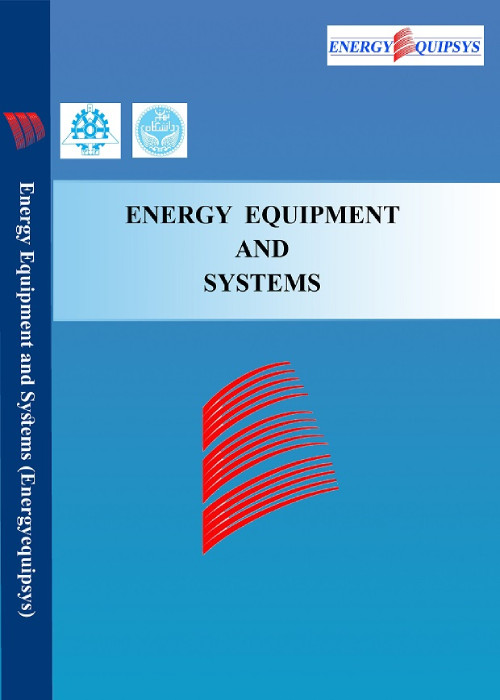فهرست مطالب

Energy Equipment and Systems
Volume:9 Issue: 1, Winter 2021
- تاریخ انتشار: 1400/01/28
- تعداد عناوین: 6
-
-
Pages 1-13
Windows are one of the most important parts of buildings responsible for wasting energy. In recent years, research works have shown that using smart windows is one of the most efficient methods to reduce the negative effects of glazings on buildings' energy consumption. In this paper, the performance of smart windows, including three types of electrochromic and five types of thermochromic ones, on reducing buildings energy consumption has been studied in four major climate regions of Iran (i.e., continental with dry summer, temperate with dry summer, steppe arid, and desert arid). Besides, to optimize the design parameters, including the building orientation, the window dimensions, and the glazing specifications, single and multi-objective genetic algorithms have been applied. The algorithms, coded in MATLAB, have been coupled with EnergyPlus building energy simulation program through jEPlus software as an interface. The results show that in the optimized case, using thermochromic and electrochromic windows decreases the annual total energy consumption 29.6% to 44.7%, and 9.3 to 26.3%, respectively, relative to the base model. The developed method and its results help to build energy engineers and architects to make the most effective decision on building parameters, which improve the energy efficiency of buildings.
Keywords: Building Energy Consumption, Electrochromic Window, Thermochromic Window, EnergyPlus, jEPlus -
Pages 14-25
The steam turbine of Ramin Ahvaz power plant is a k300-240 model manufactured by the Russian power machine company, which has six units of 300 MW. The above turbine has a rotational speed of 3000 rpm; its final blade weight is 9.2 kg. Its centrifugal force causes one of the most important and effective stresses in the blade.In this research, the first step, the forces acting on the blades such as centrifugal force are investigated, and then the stresses of these forces are calculated. By using these calculations and the properties of the blades, estimation of the blade life is made by applying stress-life correction coefficients. In the following, by using an engineering software named ABAQUS, a sample of the last row of fins is simulated. This simulated specimen after meshing is stress analyzed. By this method, the results of manual computations are compared by using different life criteria such as Goodman's and Gerber's life criteria results obtained by Abacus (finite element software). Finally, we evaluate the validity of the previous steps through the manufacturer's documentation.
Keywords: turbine blade, Life prediction, Tension, Centrifugal Force -
Pages 27-36In grinding operation, wheel topography influences the workpiece surface quality, grinding forces, abrasive grain wear and wheel loading. The difficulties associated with grinding nickel-base superalloys are mainly attributed to the high strength and low thermal diffusivity of these materials. Their high strength leads to high removal energy. The application of green machining techniques for sustainable manufacturing becomes more and more attractive nowadays to reduce the consumption of energy and cutting tools and cut fluids and consequently decrease the production costs and environmental effects. In this study, the effect of dressing parameters and wheel topography on Minimum Quantity Lubrication-MQL grinding performance of Nickel-base superalloy-Inconel 738 is investigated. In other words, to generate different grinding wheel topographies, depth of dressing and dressing speed has been changed during dressing and conditioning of vitrified Al2O3 wheels using a single point diamond dresser. After dressing grinding wheels, machining tests have been conducted to study the influence of the wheel topography and coolant-lubricant types on the performance of grinding operation (workpiece surface quality and wheel loading). The tests have been performed in the presence of fluid as well as MQL with compressed air. The results show that applying MQL technique with the optimized dressing conditions improves the grinding performance of Inconel 738. Minimum quantity lubrication implemented in the grinding process is one of the realistic alternatives that can rise the abrasive processes on a sustainable level.Keywords: Sustainable Grinding, MQL, Surface quality, Dressing, Inconel 738
-
Pages 37-52Analysis of energy consumption provides useful information for planners and policymakers to improve the efficiency of energy consumption. Given the energy crisis which caused by the consumption of non-renewable resources in agriculture sector, a lot of attempts have been made to reduce the energy consumption of inputs as much as possible. The goal of this study is to evaluate the energy efficiency and determine the optimal pattern of input consumption and improve the efficiency in apple orchards. Based on the simple random sampling method and Cochran equation, sample size was determined as 30. Based on the results, inputs energy and output were obtained as 73092 and 59537 MJ ha-1, respectively and electricity was identified as major contributor to total energy consumption with the share of 37.91% (277707 MJ ha-1). Energy efficiency (ER), energy productivity (EP) and specific energy (SE) were determined as 0.82, 0.43 kg MJ-1 and 2.36 MJ kg-1, respectively. Results showed that the total amount of cumulative energy demand is 32159.92 MJ tonne-1 for five environmental impact categories, of which non-renewable fossil resources had highest contribution to total cumulative energy demand (98%). Based on data envelopment analysis (DEA) results and using constant returns to scale (CRS), 9233 MJ ha-1 of energy could be saved, means that applying DEA can mitigate energy consumption up to 12.6% in apple orchards. Also after optimization of energy flow in orchards, energy ratio and energy productivity were improved as 12.76% and 14%, respectively.Keywords: Apple, Cumulative Energy Demand, Data Envelopment Analysis, Energy Indices
-
Pages 53-69
In this paper, the optimal combined organic Rankine-vapor compression cycle is proposed to produce cold water for hospital air conditioning using solar energy. The hospital is located in Esfarayen city and the intensity of solar radiation in all months is calculated. The results show that in the five months of May, June, July, August and September, there is the highest solar radiation in Esfarayen city. The possibility of using daily solar radiation to produce cold water during these five months is examined. Simulation is performed using the Engineering Equation Solver (EES) software. Six refrigerants R22, R134a, R600, R143a, R500, and R11 are considered as working fluids for the cycle and based on energy and exergy analysis, suitable fluid is recommended for this system. The effects of solar radiation, refrigerant, and mass flow rate of the refrigerant on the cooling water temperature outlet from the evaporator, cycle performance, organic Rankin cycle efficiency, performance coefficient of the VCC cycle, and exergy efficiency of the ORC-VCC system are investigated. The results show that using the refrigerant R22 is more suitable than other refrigerants because the cycle with this refrigerant reduced the water temperature up to 8 o C in the evaporator, as well as the cycle performance are obtained 0.72 and organic Rankin cycle efficiency is 13.9%, which will be the highest. The results show that increasing boiler thermal energy (solar radiation) reduces water temperature in the evaporator and exergy efficiency of the system, and increases organic Rankin cycle efficiency and cycle performance.
Keywords: Solar radiation, Organic Rankine-Vapor Compression Cycle, Performance Coefficient, thermodynamic analysis, Exergy Efficiency -
Pages 71-90Building energy optimization based on sensitivity analysis, considering all parameters influencing energy consumption, has not been so far implemented in Iran. Among the few previous works in this line, only one or two factors have been investigated. Thus, the present study can be introduced as the most complete one of its kind. To this end, the researchers first simulated energy consumption in a building located in the city of Dezful, southwestern Iran, with a hot and semi-humid climate, through the Quick Energy Simulation Tool (eQUEST) to illustrate thermal load for an assortment of important parameters. Then, they extracted some relationships using the SPSS Statistics, to connect energy (namely, electricity and gas) used in the building with the factors concerned. Finally, validations were performed to check the results via converting the data into neural networks and employing a genetic algorithm (GA) at each level of the study. The error between the software results and the annual gas bills was 9.2% and the error between the regression function and the measured values was ˃1%. Moreover, optimization error was about 4.3%. The results demonstrated that equipment power density and heating system efficiency were respectively among factors that could significantly affect electricity and gas consumption rates in buildings located in the climate in question.Keywords: Sensitivity analysis, Energy Optimization, Residential Complex, Hot climate, Dezful, Iran


